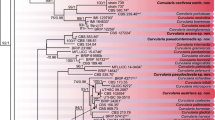Abstract
The plant-pathogenic fungus Exobasidium gracile belongs to the basidiomycetous genus Exobasidium and causes leaf abnormalities in Camellia oleifera. Here, we report a novel mycovirus from E. gracile strain Z-2, called “Exobasidium gracile zybavirus 2” (EgZV2), which is related phylogenetically to a member of the genus Zybavirus in the family Amalgaviridae. Like those of other zybaviruses, the EgZV2 genome has two large open reading frames (ORFs) encoding an unknown protein and an RNA-dependent RNA polymerase (RdRp), respectively. In addition, we found a conserved +1 programmed ribosomal frameshifting (PRF) motif (UUUCGG) between ORF1 and ORF2 in EgZV2.


Similar content being viewed by others
References
Lee CK, Lee SH, Shin HD, Park JH, Sieber T (2015) First report of Exobasidium gracile causing hypertrophied leaves of Camellia sasanquain South Korea. Forest Pathol 45(3):258–261
Dong Z, Liu W, Zhou D, Li P, Wang T, Sun K, Zhao Y, Wang J, Wang B, Chen Y (2019) Bioactive exopolysaccharides reveal Camellia oleifera infected by the fungus Exobasidium gracile could have a functional use. Molecules 24(11):2048
Kotta-Loizou I (2019) Mycoviruses past, present, and future. Viruses 11(4):361
Li P, Wang S, Zhang L, Qiu D, Zhou X, Guo L (2020) A tripartite ssDNA mycovirus from a plant pathogenic fungus is infectious as cloned DNA and purified virions. Sci Adv 6(14):eaay9634
Zhang T, Cai X, Zeng Z, Du H, Liu H (2020) A novel totivirus isolated from the phytopathogenic fungus Rhodosporidiobolus odoratus strain GZ2017. Arch Virol 165(8):1911–1914
Park D, Hahn Y (2017) Genome sequences of Spinach Deltapartitivirus 1, Spinach Amalgavirus 1, and Spinach Latent Virus identified in Spinach transcriptome. J Microbiol Biotechnol 27(7):1324–1330
Vainio EJ, Sutela S (2020) Mixed infection by a partitivirus and a negative-sense RNA virus related to mymonaviruses in the polypore fungus Bondarzewia berkeleyi. Virus Res 286:198079
Nibert ML, Pyle JD, Firth AE (2016) A +1 ribosomal frameshifting motif prevalent among plant amalgaviruses. Virology 498:201–208
Park D, Goh CJ, Kim H, Hahn Y (2018) Identification of two novel amalgaviruses in the common eelgrass (Zostera marina) and in silico analysis of the Amalgavirus +1 programmed ribosomal frameshifting sites. Plant Pathol J 34(2):150–156
Depierreux D, Vong M, Nibert ML (2016) Nucleotide sequence of Zygosaccharomyces bailii virus Z: Evidence for +1 programmed ribosomal frameshifting and for assignment to family Amalgaviridae. Virus Res 217:115–124
Pyle JD, Keeling PJ, Nibert ML (2017) Amalga-like virus infecting Antonospora locustae, a microsporidian pathogen of grasshoppers, plus related viruses associated with other arthropods. Virus Res 233:95–104
Lee JS, Goh CJ, Park D, Hahn Y (2019) Identification of a novel plant RNA virus species of the genus Amalgavirus in the family Amalgaviridae from chia (Salvia hispanica). Genes Genomics 41:507–514
Goh CJ, Park D, Lee JS, Sebastiani F, Hahn Y (2018) Identification of a novel plant amalgavirus (Amalgavirus, Amalgaviridae) genome sequence in Cistus incanus. Acta Virol 62(2):122–128
Zhang T, Cai X, Teng L, Li X, Zhong N, Liu H (2022) Molecular characterization of three novel mycoviruses in the plant pathogenic fungus Exobasidium gracile. Virus Res 307:198608
Morris TJ, Dodds JA (1979) Isolation and analysis of double-stranded RNA from virus-infected plant and fungal tissue. Phytopathology 69(8):854–858
Xie J, Wei D, Jiang D, Fu Y, Li G, Ghabrial S, Peng Y (2006) Characterization of debilitation-associated mycovirus infecting the plant-pathogenic fungus Sclerotinia sclerotiorum. J Gen Virol 87(Pt 1):241–249
Lambden PR, Cooke SJ, Caul EO, Clarke IN (1992) Cloning of noncultivatable human rotavirus by single primer amplification. J Virol 66(3):1817–1822
Zadeh JN, Steenberg CD, Bois JS, Wolfe BR, Pierce MB, Khan AR, Dirks RM, Pierce NA (2011) NUPACK: analysis and design of nucleic acid systems. J Comput Chem 32(1):170–173
Acknowledgments
This work was supported by the National Natural Science Foundation of China (grant numbers 31760015) and Guizhou Provincial Natural Science Foundation (grant numbers ZK [2021]081, [2018]5779-53).
Author information
Authors and Affiliations
Corresponding authors
Ethics declarations
Conflict of interest
The authors declare no competing interests.
Ethical approval
This article does not contain any studies involving human participants or animals.
Additional information
Handling Editor: Ioly Kotta-Loizou.
Publisher's Note
Springer Nature remains neutral with regard to jurisdictional claims in published maps and institutional affiliations.
Rights and permissions
About this article
Cite this article
Teng, L., Li, X., Cai, X. et al. The complete genome sequence of a novel mycovirus in the plant-pathogenic fungus Exobasidium gracile. Arch Virol 167, 1343–1347 (2022). https://doi.org/10.1007/s00705-022-05421-x
Received:
Accepted:
Published:
Issue Date:
DOI: https://doi.org/10.1007/s00705-022-05421-x




